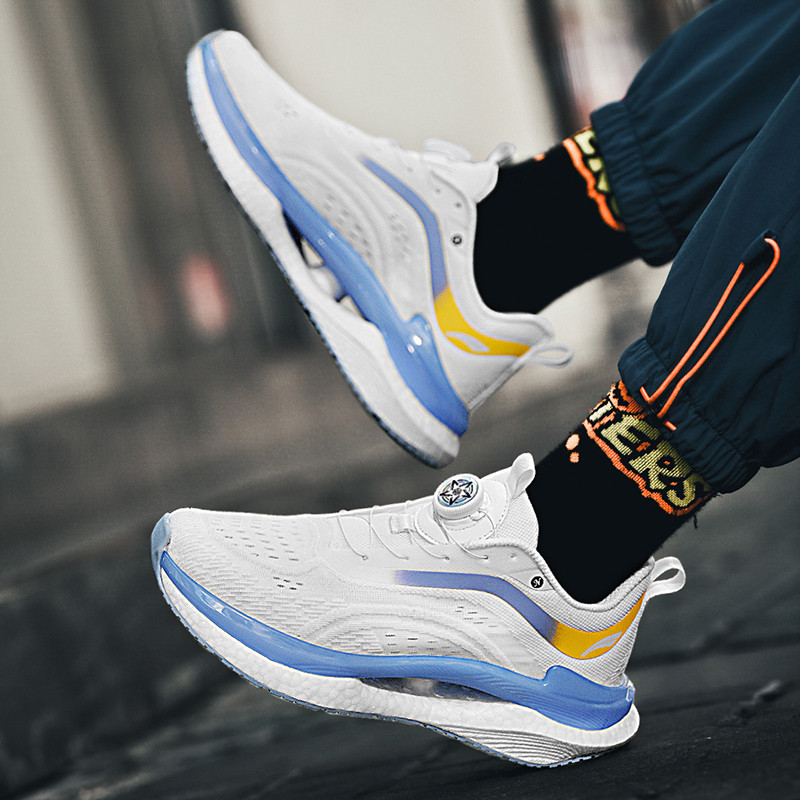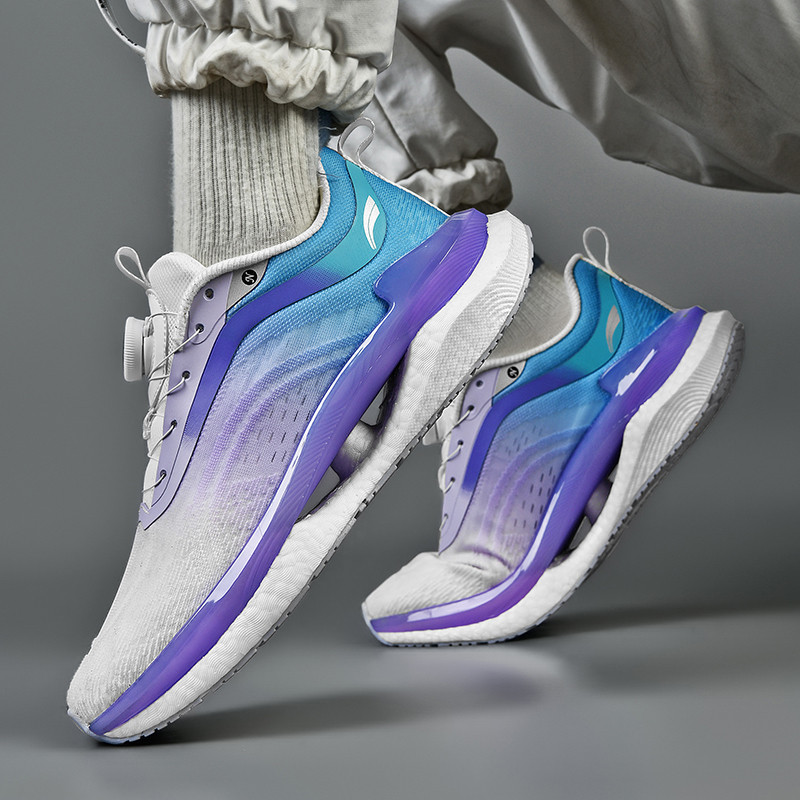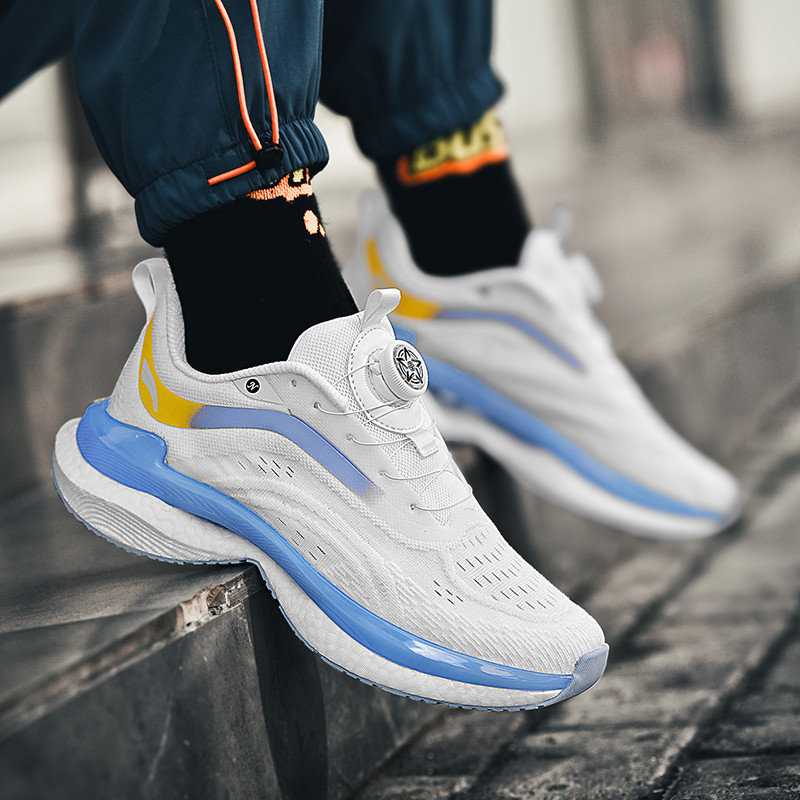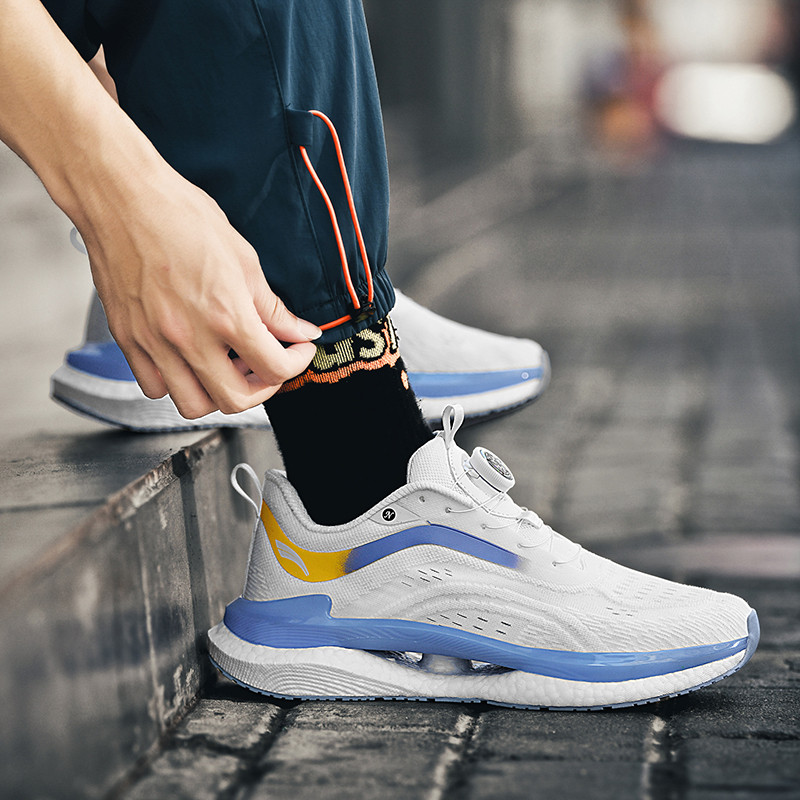Essential Features of Long Distance Running Shoes
Choosing the best cushioned running shoes goes beyond mere style and brand appeal. As a marathoner, you understand that these shoes are the critical link between you and the road. Here are essential features to look for:

- Fit: A snug, yet comfortable fit is non-negotiable. Your shoes should feel like an extension of your feet.
- Cushioning: Adequate cushioning in the midsole protects your joints on long runs. However, too much can reduce responsiveness.
- Support: Look for shoes that offer good arch support and help stabilize your feet during your stride.
- Durability: High-wear areas like the heel and toe should be reinforced. Durable materials will withstand the demands of training and racing.
- Traction: The outsole should provide a reliable grip on various surfaces without compromising flexibility.
- Breathability: Good air flow helps to keep your feet cool and reduces the risk of blisters.
- Weight: Lighter shoes can improve running efficiency but don’t sacrifice support for weight.
- Flexibility: The shoe should allow natural foot movement and align with your unique running gait.
When you find a shoe that ticks all these boxes, you’ve likely found a good match. Keep these features in mind to ensure your long distance running shoes carry you through training and to the finish line with comfort and stability.
The Importance of Proper Fit
Proper fit in long distance running shoes is vital for marathon success. Without it, even the best features lose their value. Shoes that fit well prevent common injuries and blisters. They allow your toes enough room to move without slipping. Always measure your feet before buying, as size can change over time. Remember, your feet swell during long runs; consider this when choosing a size. A thumb’s width of space at the end of the shoe is a good measure. Make sure the heel fits snugly, without tightness or rubbing. Check the fit across your instep; it should feel secure but not constrictive. For the best fit, shop later in the day when your feet are at their largest. And never overlook the importance of lacing; it affects both fit and comfort.
Cushioning and Support: Balance is Key
Finding the perfect balance between cushioning and support in long distance running shoes is crucial. Both elements play significant roles in comfort and injury prevention over many miles. Let’s explore why balance matters and what to look for in running shoes.

Why Balance Matters
Too much cushioning can cause a loss of ground feel, reducing your run’s efficiency. Conversely, not enough cushioning may lead to joint stress. The right support helps maintain foot stability, preventing overpronation or supination which can cause injuries.
What to Look for in Running Shoes
Seek moderate cushioning in the midsole to absorb impact without losing touch with the ground. Ensure the shoe has a supportive structure, especially around the arch. A good shoe will have features like a well-designed heel counter and midfoot shanks for added stability.
Remember, the perfect shoe should complement your natural stride and running style. Everyone’s needs differ, so you may need to try several models to find the one that offers the best combination for you. Aim to tick this box, and you’re one step closer to marathon success.
Material and Construction: Durability for the Long Run
When selecting long distance running shoes, the material and construction matter immensely. Durability is critical as these shoes will face many miles of wear and tear. Look for materials that can withstand repeated pounding on pavement or trails.
Consider the following when assessing the durability of running shoes:
- Upper Material: It should be strong yet flexible to move with your foot. Mesh or synthetic overlays are common and provide good balance between toughness and breathability.
- Midsole Construction: This is the shoe’s shock-absorbing core. Quality foam or gels increase the lifespan of the shoe. They prevent breakdown under heavy mileage.
- Outsole Design: Opt for thick rubber outsoles with well-spaced lugs. They offer better longevity and are suitable for varying terrains.
- Reinforcement: High-wear areas like the heels and toes should have extra reinforcement. It helps shoes last longer and retain their shape.
- Stitching: Solid stitching adds to shoe strength. It keeps the shoe intact through extensive training routines.
In summary, good long distance running shoes combine resilient materials with robust construction. They ensure that your investment pays off, mile after mile. Make sure the shoes you pick can go the distance just as you intend to.
The Role of Outsole Traction on Diverse Terrains
Traction on long distance running shoes is a critical feature. It ensures safety and performance across various surfaces. When you run in a marathon, you encounter different terrains. The outsole of your shoes needs to grip these effectively.
Here are key points to consider when evaluating outsole traction:
- Surface Compatibility: Your shoes should handle asphalt, trails, and even slick conditions. Different patterns and rubber compounds cater to specific terrains.
- Lug Pattern: Well-designed lugs provide grip on dirt and improve stability. They should be spaced to prevent debris from getting lodged.
- Abrasion Resistance: A durable rubber outsole resists wear. It keeps the traction features intact longer, thus delivering better performance.
- Flexibility and Grip: The outsole should bend with your foot’s natural movement. At the same time, it must ensure a firm hold on the ground beneath.
The best long distance running shoes offer outsoles that match the marathoner’s needs. They keep you connected to the ground in all conditions. This boosts confidence and helps prevent slips and falls. Check the outsole carefully when choosing your next pair of long distance running shoes.
Breathability and Weight: Keeping Feet Fresh and Light
When running long distances, comfort is key, and that heavily depends on the breathability and weight of your running shoes. Breathability is vital in preventing overheating and keeping your feet dry. This reduces the risk of blisters, which can be a real problem on long runs. Look for shoes with lightweight, breathable mesh uppers that allow air to circulate around your feet.
Weight is equally important. Heavier shoes can slow you down and increase fatigue over time. Lighter shoes contribute to better energy efficiency, helping you maintain your pace without unnecessary strain. However, it’s important to balance weight with support; too little can lead to foot and ankle injuries. Aim for a shoe that feels light on your feet but still provides the structure and stability you need.
Here are key points to remember:
- Search for shoes with mesh uppers or other breathable materials.
- Lightweight design can boost running efficiency.
- Ensure shoes combine lightness with necessary support.
- Consider shoes with moisture-wicking linings to keep feet dry.
By keeping these factors in mind, your long distance running shoes will help carry you through the miles with cool, comfortable feet, ready for the marathon challenge ahead.

Shoe Flexibility and Your Running Gait
Flexibility in long distance running shoes is essential for a natural feel and movement. The design should let your foot flex, twist, and bend in a way that’s close to your barefoot running gait. This can lead to better performance and reduced risk of injury.
- Match Your Gait: Shoes should complement your unique running style, whether you’re an overpronator, underpronator, or neutral runner.
- Natural Movement: Look for shoes that allow natural foot motion without excess control.
- Test for Flexibility: Gently twist and bend the shoe to see if it mirrors the motion of your foot.
It’s about finding shoes that feel like a part of you. They should enhance, not hinder, the way you naturally run. Be sure to try different shoes to see which ones sync best with your personal running gait.
Top Picks: Reviewing the Best Marathon Running Shoes
When it comes to finding the best cushioned running shoes for marathons, many options are available. To help you cut through the noise, we have put together our top picks. These selections stand out for their exceptional balance of the critical features outlined earlier – cushioning, support, durability, traction, breathability, and weight. We’ve kept in mind the need for flexibility to match your running gait, ensuring these shoes rise to the challenges of marathon running.
- The Stamina Enhancer: Perfect for those who prioritize endurance. Offers solid arch support with moderate cushioning. A reliable choice for regular marathon training.
- The Fleet-Footed Glide: Ideal for runners who love speed. Their lightweight construction doesn’t compromise on stability. Enhanced with high abrasion-resistant outsoles.
- The Agile Adventurer: Built for varied terrain. These shoes provide excellent grip and are robust enough to tackle trail sections.
- The Breezy Strider: Features a top-notch mesh upper, allowing your feet to breathe easily on long runs. These strike a perfect balance between lightness and support.
- The Natural Performer: Best for those seeking a shoe with natural flexibility. They align closely with the runner’s gait, promoting comfort and reducing injury risks.
Each of these long distance running shoes have been crafted to meet the demands of marathon runners. From the cushioning to the traction, they represent the best of design, allowing runners to focus on their performance, knowing their footwear will go the distance. Remember to test them thoroughly to ensure the fit is just right and that they align with your specific running needs and style. The final step? Lace up and start the journey to your next marathon with confidence.
